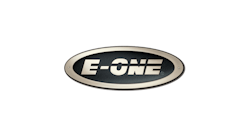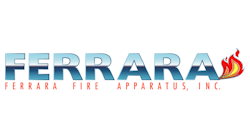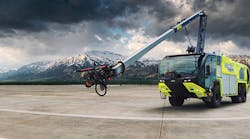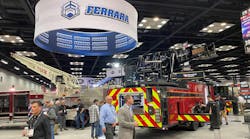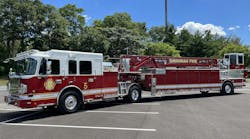Ferrara: As modern buildings increase in size, the need for aerial units to reach greater heights will be required.
Crash Rescue: There may be some more specialized vehicles with larger aerials. However, I think mainline units will remain similar to today's units.
Saulsbury: The major concern we have with aerial devices increasing in size is weight factors versus the size of the unit.
E-One: The market trend is keeping most aerial products in the range of 75 to 100 feet. The ISO (Insurance Services Organization) has impacted this trend making it hard to justify anything over 100 feet. However, many departments still have a need for both reach and height. We believe platforms will begin to dominate this category. The new Bronto F118 HDT is a good example. It has a platform height of 118 feet and also has an excellent side reach of 84 feet in order to reach homes that are set back from the road, a very common problem in suburbia. We believe this market segment will grow in North America and that Bronto, the worldwide market leader, will be a major player.
KME: It seems the apparatus manufacturers are trying to make the aerial devices smaller in wheelbase and overall length and at the same time reach the same 75-foot and 100-foot vertical heights.
American LaFrance: The challenge in developing higher aerials is keeping the overall height and gross vehicle weight in check. As the development and use of composite materials and electronic systems for the design of aerial devices and their controls evolve, so will their ability to bear increased loads at greater heights with greater safety and stability than is available today. Aerial devices constructed of composite materials will be lighter and stronger, allowing greater loading and will benefit from improved resistance to thermal effects and corrosion.
These units will use operating envelope control systems and load moment indicating systems that will enable the aerials to reach greater heights without sacrificing stability or increasing outrigger stance.
Pierce: Aerials today are being used not only for rescue operations and elevated water towers, but EMS and engine company operation as well. The architecture in Europe has mandated the use of longer aerial devices for years. In the U.S., it's possible that the physical stature of aerial devices will continue to grow higher, longer and heavier, as these device are being called to do so many different functions. However, according to Pierce's research, longer aerials devices aren't the answer. Firefighters prefer that manufacturers emphasize safety and ease of operation for the wide range of aerials already on the market. According to our customer feedback, an internal attack is needed to effectively fight fire 10 stories in the air in any case, and water at heights above 105 feet are limited due to the pressures needed to pump the water that high. Horizontal reach and high load ratings are more important to effective aerial firefighting than reach.
Smeal: No. The North American aerial market requires vertical reach, but equally important is the horizontal reach with a large live load capacity. The high load capacities of today's aerials, while operating at low angles, are limited by the stability requirements of the machine. NFPA requires that all aerials be tested to 11/2 times the rated load with the aerial positioned in the most unstable condition. Maneuverability of the apparatus is also a concern. The overall travel heights, overall travel lengths and the finished weights of the larger aerial models are pretty much at the limit.
How will comfort and climate be addressed in cab design and riding positions?
Hackney: Larger cabs are growing in popularity. We have seen a big upward shift in the number of custom fire truck cabs this past year for rescue truck applications. Again, this is primarily to provide larger and more comfortable rehab zones or small command centers.
Pierce: More interior space is a primary design element of a comfortable cab. At Pierce, we scrutinize all dimensional areas of the cab carefully to accomplish that. For example, we taper the engine tunnel to provide more upper body and elbow room. Basically we try to shrinkwrap the engine tunnel over the engine to give us as much room as possible in the cab, but still allow room for the engine and its peripheral components. The Pierce Quantum has the smallest engine tunnel of any custom fire chassis available. In the Quantum, Pierce revolutionized custom fire chassis design by raising the cab, positioning wire harnesses at the front exterior of the cab, and designing fold-down steps to provide the largest cab interior space available to the fire service. Beyond that, we ensure the air intake tunnel and air filter are the correct size to optimize legroom, such as 27 inches in the Quantum.
Control and switch positioning is also vitally important to driver and passenger comfort. Wrap-around, cockpit-style dashes are becoming the norm to put controls within easy reach.
Temperature is the other crucial element of a comfortable cab environment. At Pierce, air conditioning systems are customized to the regional climate. Our hot-weather package, adds a third evaporator to the standard system which features a large 19.1-cubic-inch compressor.
Crash Rescue: I think you will see improvements in seats, instrument panels, visibility and the use of more camera systems. Cabs will be quieter with increased passenger room and better climate control. Some ARFF vehicles have a driver-forward position in the center with passengers riding off-set on either side in a slightly raised position for visibility.
American LaFrance: We utilize ergonomics and human factors to provide the basis for the development and design of vehicle interior seating, controls and HVAC systems. In addition, we make every attempt to utilize the advances made by Freightliner in the design of vehicle interior components. Testing to known standards and mandated regulations is used to validate new product designs and components. During the course of our development, the use of full-scale interior packaging "bucks" are used to allow real people to evaluate product development and provide input into the final design configuration.
KME: New materials are being developed to better insulate the cab along with more efficient climate control systems.
E-One: This area of the apparatus is always in a "continuous improvement" mode. We currently provide automotive-level air conditioning and state-of-the-art, ergonomically designed seats. This will always remain a focus of improvement.
Saulsbury: Saulsbury does not manufacture chassis and cabs, but we are working with our suppliers to influence design. The use of the chassis as a rehabilitation center for firefighters is increasing, mostly in the area of climate control, i.e., heat for colder climates and air conditioning for the warmer climates.
Ferrara: The industry has been already moving towards comfort in the cab, with major changes in ergonomics, sound level and location of the controls and instrumentation so as to allow the driver more time keeping his eyes straight ahead and on the road.
Where is the industry going in regards to safety and crashworthiness of apparatus?
KME: Enhancements in lighting and signaling systems will continue to assist in increasing safety, especially with some of the new LED technology available today. In regard to crashworthiness, I am sure that the apparatus industry will follow the lead of the over-the-road market to increase personnel safety.
E-One: E-One is in agreement that ultimately there will be (and is needed) an industrywide testing standard. We have taken the approach of ensuring that our cabs maintain superior structural integrity. Decades of field performance, in all areas of crash worthiness, has proven E-One to be the leader in this regard.
Ferrara: I think regulations will continue to change where the safety of the fire apparatus passengers will become more of a priority. Plus the need for less down time after an incident, out of service, will be what the industry will look to in the future purchases.
American LaFrance: American LaFrance is the only U.S. fire truck manufacturer to develop and certify its cabs to an established standard for occupant protection for heavy truck, the United Nations/European Commission on Economics Regulation #29 (UN/ECE R-29). The Society of Automotive Engineers (SAE) is currently developing recommended practices for the testing of occupant protection in heavy truck cabs. Once these recommended practices have been approved, they may become part of federally mandated legislation, which would require compliance. At the very least, they will become a recognized U.S. design practice, which will be difficult for manufacturers to ignore in the future.
Saulsbury: Transport of personnel to and from the scene is done in the chassis portion of the apparatus. Saulsbury is primarily a body manufacturer and we work with our suppliers to influence and keep up with safety in their cabs.
Hackney: Safety and crashworthiness has always been a paramount issue to the major apparatus manufacturers, if for no other reason than to reduce liability exposure. For instance, Hackney limits the type of seating configurations to only those that have been independently tested to meet FMVSS requirements. We no longer offer a configuration that forces the occupants to sit sideways while the apparatus is in transit. The risk of serious injury is greatly increased in this position should the apparatus be involved in a frontal zone crash. Where there is potential for upper torso contact with interior objects, shoulder restraints are required, whether the buyer wants them or not.
With the advent of electronic engines and transmissions, many safety features can be incorporated into the design of the apparatus. For instance, Hackney provides a mandatory transmission-disable circuit whenever a telescoping light tower is installed that prevents the apparatus from being moved anytime the tower is not nested. This prevents accidental electrocution should someone drive the apparatus under power lines.
Pierce: Ironically, custom fire truck cabs are among the strongest structurally built vehicles in the world. Our cabs are the heaviest built and most crashworthy cab-overs in the truck industry. Commercial truck cabs won't likely change unless FMVSS changes their standards.
Are there ways for fire departments to reduce overall costs of purchasing apparatus?
E-One: Yes. One of the best ways for departments to reduce costs when purchasing is to use the old "80/20" rule. The objective is to spec 80% of the vehicle without customization. By setting a goal of keeping the customization of the vehicle below 20%, fire departments create the opportunity to reduce their overall costs. Another good idea is to have several small communities get together, follow the 80/20 rule and then purchase all of the vehicles as a group. A fleet approach could also save the departments some money.
Smeal: Many departments "over spec" their trucks. A truck committee needs to do its homework by researching new technology and then applying it to what is really needed for their department. Their specs should be written accordingly. Many departments try to design the truck that has everything and then they want the manufacturers to build it. This is a "custom truck" industry, but there is such a thing as overkill. Beyond a certain point, the price of an apparatus raises considerably.
Hackney: There are always ways to reduce apparatus purchase cost. Typically, procure costs soar when an apparatus is designed by the infamous "committee," meaning each member wants to incorporate something that turned them on at the last exhibition they attended. The end result is an apparatus that no one single manufacturer can build without the purchasing agency incurring greatly inflated manufacturing cost. The ideal means of reducing cost is to purchase an apparatus that provides an efficient means of accomplishing the designated mission for which it is to be purchased to accomplish. Each manufacturer works with his own manufacturing standards. If allowed to work within those parameters, the purchase price will be significantly reduced. Typically, stretching the compartment sizes isn't a cost issue.
Crash Rescue: The most significant cost reduction is for multiple vehicle purchases. I think you will see more departments going together on a single design to reduce cost.
Pierce: Leasing programs are gaining popularity and may be a way of reducing costs to purchase apparatus. Tax-free municipal leasing has been available for years. Now available are true leasing programs that are attractive to fire departments that are operating on limited budgets. Departments can acquire a fire truck for low annual payments, which can be considered part of the operating budget, freeing up much-needed capital. Basically, departments pay for what they use. Pierce offers the most comprehensive package of leasing options on the market to allow departments to improve their replacement programs and acquire the latest technology on an on-going basis.
Joint purchasing arrangements between departments on a regional level are becoming more common. Pierce developed a proposal for a variety of apparatus configurations for the Northeast Municipal Purchasing Cooperative - a joint effort by departments in the greater Chicago metropolitan area. It allows Pierce to take advantage of economies of scale in engineering, manufacturing and purchasing, while the departments benefit from volume pricing and simplified purchasing. When departments can agree on purchasing similar apparatus, manufacturers are in a position to offer multiple-order discounts. Likewise, many fire departments consider tagging on to large municipal orders to obtain discounted pricing. For example, the city of Los Angeles leads the trend in apparatus configuration and selection in Southern California. In addition to the 33 Pierce apparatus purchased by L.A., similar configurations are being ordered by surrounding communities.
American LaFrance: Standardization and the use of tried and proven components, technology and vehicle configurations are among the best methods for customers to control the rising costs of new equipment. Specifying equipment that has been tested for compliance and durability is also critical. In addition, vehicle leasing and new fleet management practices, maintenance agreements and extended warranties can all be used to lower the total cost of ownership to the fire and emergency services.
Ferrara: One way is refurbishing their old apparatus. They can also lean toward manufactured program trucks rather than customizing.
KME: Bid specifications that do not require brand-specific components allow manufacturers to provide accessories that have already been incorporated into their vehicle design. Additionally, it would be highly recommended, upon completion of a department's bid specification, to have a vehicle manufacturer do a design review of the specified unit to ensure that the bid requirements will not require an excessive amount of engineering on any proposed apparatus.
Saulsbury: To reduce the cost of apparatus a fire department should work with the manufacturer to utilize standard production techniques that will not require extensive engineering and testing. Keep the unit simple and not complex. If it is complex to design and build, then it is also complex to operate or maintain.
Where is the industry heading in regards to braking systems, multi-wheel-drive and engine size?
Pierce: With the advent of ABS systems the fire industry has caught up quickly with the auto and the over-the-road trucking industry. ABS is standard on all Pierce chassis. Above and beyond this we allow for electro-magnetic driveline brakes, engine brakes and transmission retarders to assist in braking. Pierce already offers optional systems which warn if it is clear to make a lane change or advise how close the vehicle is to another object while backing up. Future braking systems may allow for optional systems which warn drivers that they are encroaching on an vehicle or object ahead of them, thus allowing more time to react when braking.
Multi-wheel-drive systems are becoming more popular, particularly for urban/wildland interface applications and in areas that require advanced mobility. Pierce offers all-wheel-drive configurations on the majority of custom chassis. If you need extra traction on a Pierce chassis, we have it with up to 500- hp engines to move you around. It's likely that the offering of all-wheel-drive trucks will only increase.
We will see a big demand placed on the horsepower ratings applied to all of the engines used in the fire industry. With the EPA (Environmental Protection Agency) issues that will be enforced in the year 2002, efficiently cooling engines while maintaining horsepower ratings will be the primary challenge. To effectively cool engines under the new EPA guidelines means that larger radiators will have to be installed or additional radiators with electric fans will be added. Exhaust Gas Recirculation (EGR) will also be added to the engines, and they will have to be cooled properly. All of this could mean changes to the cab design to accommodate more space for the engine.
Saulsbury: Chassis manufacturers are already utilizing the use of antilock braking systems and a secondary braking device; these requirements are staying current with the heavy truck requirements. Multi-wheel-drive units depend upon the topographic area and fire department requirements of the area. Engines are becoming larger and more powerful.
American LaFrance: The primary challenge facing manufacturers with the development of fire and emergency service vehicles is market size. The cost to develop components that are unique to the fire and emergency service is prohibitive. Therefore, as in the past, the challenge will be to locate and utilize componentry and technology that has been developed for commercial vehicles and apply it to our vocation.
A central emphasis of commercial vehicle development is the development of components and vehicle systems designed to improve safety and operator productivity. There will be continued emphasis on integrated electronic vehicle systems and controls, vehicle stability and braking systems, occupant protection and vehicle collision avoidance systems. Emissions requirements and resulting design changes will dictate how today's engines will be rated for brake horsepower and torque. It is possible that the customer may have to select larger engine displacements/models in the future to obtain the same horsepower and torque that are available today in smaller engines. This will cause departments to scrutinize how the vehicle must be configured to accomplish its intended missions and may lead to increased quantities of smaller, lighter vehicles.
Crash Rescue: I think antilock braking, all-wheel drive and rear steer will become more common. Engines will continue to increase in power while improving in emissions and noise levels. New power sources or drive systems may emerge such as hydraulic drive at each wheel instead of an engine/ transmission/driveline. With hydraulic drive, the engine can be located anywhere on the vehicle.
KME: I believe that as manufacturers of major components, such as engines, transmissions and axles, make new products available, the industry will immediately react to new systems for braking and engine size. Multi-wheel-drive systems will have a lesser impact unless component manufacturers develop new technology to reduce costs.
E-One: The engine size is reaching the limit in the average fire apparatus. New advancements will be in obtaining the same 350-400 horsepower, but with less weight. The larger engines really impact the ergonomics of the cab interior.
E-One was the first fire truck manufacturer to go to ABS on all vehicles. We continue to lead in this area, making conscious improvements and going beyond all regular standards. We do not believe there is any trend to multi-wheel-drive. This is really driven by geographic location and is currently available if a department requests it.
Are there any new advances in rust or corrosion protection?
Smeal: Yes. Technology is always improving and will continue to do so.
E-One: E-One has new patented treatments to aluminum allowing major advancements in our paint coating and our primer systems. Thus, we have the best warranty (if not the only warranty) on the paint of a fire apparatus. The industry, as a whole, continues to advance by much more standard use of aluminum and stainless steel bodies and plumbing.
Crash Rescue: Corrosion protection will come in the form of new materials - composites, fiberglass, plastic compounds, carbon fiber, etc.
American LaFrance: The use of composite materials in place of the more traditional ferrous and non-ferrous materials used today will increase. These materials are more corrosion resistant, contribute to reduced vehicle weight and are significantly easier to maintain. Once tooled, the replacement cost of these parts is also lower, which could provide a lower cost of ownership over the life of the vehicle. The primary drawback from the use of these materials is the initial high cost to develop the tooling required to manufacture these components. To make these components cost effective for manufacturers to consider there must be volume, which ultimately requires various forms of standardization within the product lines offered or within the industry as a whole. But, I do see these products and processes having increased usage as today's more traditional material costs increase and there is increased pressure to develop more components that have the ability of being recycled.
KME: Stainless steel is still one of the best defenses against corrosion. New technology in paint and corrosion inhibitor systems as well as material scuff protection finishes will be incorporated into apparatus of the future.
Pierce: With the elimination of lead and chromates in paint, this has been a challenge for all apparatus manufacturers. Process controls, the isolation of dissimilar materials and the use of specialty fasteners are all helping. There is a renewed interest in petroleum-based spray-on products that keep water and salt out of body crevices.
Saulsbury: Saulsbury is primarily a builder of stainless steel apparatus. This material does not require a rust or corrosion protection material.
How will future electrical systems and load management be incorporated in overall design and use?
American LaFrance: As with today's commercial vehicles, the fire and emergency vehicle vocation will continue to see an increase in the integration of the vehicle electronic systems. This will increase its dependence on the networking of these systems to eliminate redundancy and cost and also to improve diagnostics and communication with the operator of these vehicles.
What we are seeing in today's vehicles is only the beginning. Freightliner has already announced their development of the Truck Productivity PC, which is an on-board PC integrated into the vehicle communications and electronic systems. When released for production later this year, the operator will have all the features and benefits of a personal computer, GPS navigation, wireless communication system, digital entertainment system and vehicle diagnostics assistant all within a package that fits within a DIN 1 or DIN 2 panel opening. American LaFrance will also be able to make this product available to the fire and emergency services vocation, further integrating the Eagle and Metropolitan systems.
KME: Multiplexing systems and load management systems are already utilized throughout the industry. I believe that LED technology, especially "Clear LED," will be the next step in reducing electrical system load requirements.
Saulsbury: Electrical requirements of apparatus increase every year. The use of a multiplexing system will be very beneficial once the research and testing of such system proves to be reliable and adaptable with fire apparatus.
Pierce: The trend in electrical systems design is toward simplicity for the end-user - in operation, maintenance and diagnostics. Pierce leads the industry in this regard. We are the only apparatus manufacturer to offer a fully integrated state-of-the-art multiplexed system called Command Zone™ on our Dash 2000 & Lance 2000 chassis. This electrical system allows the chassis to talk electronically with the engine and transmission, while sending multiple messages over a data link (computer cable) to other locations on the truck. The system can provide RPMs, engine temperatures, fuel levels, system voltage and more on a display in the cab or on the pump panel. The Command Zone eliminates the need for a bulky main wire harness and incorporates a single twisted- pair wire (computer cable) to take over the old electronic highway performed by hundreds of different circuits. Not only is there a space and weight savings with this system, but it also allows for on-board diagnostics, which will reduce troubleshooting time by as much as 50%. To add to the list this system allows for load management and sequential switching as standard and we can reprogram your truck from Pierce via modem while the customer's truck sits in their own fire station.
What we see for future electrical systems is doing more with less componentry. Optical displays, which can provide brilliant resolution for the various bar graphs, load management status, compass, stopwatch, operating information and help notes for warnings will become the standard.
Crash Rescue: I believe we are closest to the future with these items. Load management is commonplace and most manufacturers are rapidly developing multiplexed electrical systems that will be simpler to install and troubleshoot. Multiplexing will open up more options such as improved pump and aerial controls, more convenience features in the cab (power windows, power mirrors, power seats, adjustable pedals, etc.) and most anything the automobile or electronic industries offer.
Hackney: All major manufacturers have been incorporating load management systems as standard for at least four years. Standardization is the key to reducing system failures, increasing longevity and simplifying diagnosis and service. Prefabricated, "bench-made" wiring harnesses reduce the number of splices and poor connections to a bare minimum. The end result is better dependability and lower cost to the end user. For many years, wiring systems were the nemesis of the fire service. Overloading the systems was the primary culprit. Poor connections, based on human error, was the second. To counter this, many larger departments took it upon themselves to remedy the situation and incorporated requirements in specifications for wiring systems that met their stringent criteria. The result was "Band-Aiding" the problem and dramatically increasing cost. Today, higher output alternators, load managed systems and machine-made harnesses have virtually eliminated major problems. The only problem left is that of over-loading the electrical system with an array of emergency lights. Thankfully, NFPA 1901 has significantly reduced that problem by stipulating minimums and maximums. Most departments have elected to follow those guidelines and the end results is a dependable electrical system.
Ferrara: The need for simplified troubleshooting and manageability to electrical layout changes is moving our electrical systems towards the use of more computer-controlled load managers with the added convenience of remote management.
E-One: Electrical advancements, through multi-plexing, etc., will allow the entire vehicle to interact as one "smart system."
Smeal: Operator error will be decreased and the safety mechanisms of a truck will be improved. Another added benefit will be in the area of troubleshooting when malfunctions occur. Downtime of an apparatus will be reduced considerably.
Related:
